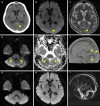Cerebral Venous Thrombosis Mimicking Limbic Encephalitis
- PMID: 37612080
- PMCID: PMC11116027
- DOI: 10.2169/internalmedicine.2514-23
Cerebral Venous Thrombosis Mimicking Limbic Encephalitis
Abstract
Cerebral venous thrombosis (CVT) is challenging to diagnose, as it presents with variable symptoms. We encountered a complicated case of CVT that mimicked limbic encephalitis due to sensory aphasia. Based on the characteristic magnetic resonance imaging findings, this 72-year-old Japanese man was later confirmed to have CVT, the cause of which was periodontitis due to Eikenella corrodens, a Gram-negative facultative anaerobic that is part of the mouth's normal flora. The symptoms improved without sequelae following anticoagulation treatment and antibiotics. Clinicians should consider CVT as a differential diagnosis when unexplainable neurological symptoms suggesting limbic encephalitis are observed.
Keywords: cerebral venous thrombosis; infectious disease; limbic encephalitis; periodontal infection.
Conflict of interest statement
Figures

References
-
- Bousser MG, Ferro JM. Cerebral venous thrombosis: an update. Lancet Neurol 6: 162-170, 2007. - PubMed
-
- Ferro JM, Aguiar de Sousa D. Cerebral venous thrombosis: an update. Curr Neurol Neurosci Rep 19: 74, 2019. - PubMed
-
- Silvis SM, de Sousa DA, Ferro JM, Coutinho JM. Cerebral venous thrombosis. Nat Rev Neurol 13: 555-565, 2017. - PubMed

